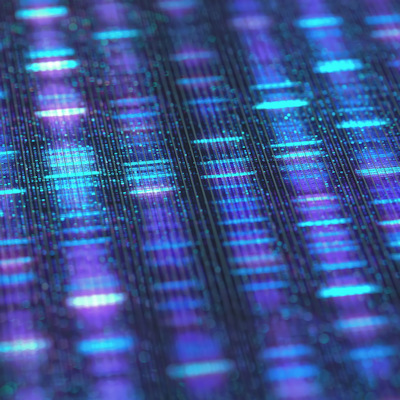March 10, 2021 -- Researchers found that RNA editing events can have large downstream effects that influence gene expression and subsequent phenotypic manifestations of that expression. RNA editing may be a previously underappreciated mechanism driving human diseases, according to an analysis published in Genome Biology on March 9.
RNA editing is a cellular process in which the sequence in mature RNA molecules is enzymatically altered from the genomic sequence. Altered levels of RNA editing have been associated with cancers and various other neurological conditions.
The most common RNA editing event in animals is adenosine (A) to an inosine (I) RNA editing, in which adenosines are deaminated to inosines. This A-to-I RNA editing is mediated by members of the adenosine deaminase acting on RNA (ADAR) family.
These editing events can produce a variety of functional outcomes, including changes to the protein products of messenger RNAs (mRNAs), pre-mRNA alternative splicing, transcript localization, and transcript stability. Most events take place in the noncoding regions of mRNA, such as introns and untranslated regions.
"Millions of A-to-I RNA editing sites have been identified across the human transcriptome, but the functions of most RNA editing events are unknown," said senior author Yi Xing, PhD, director of the Center for Computational and Genomic Medicine at the Children's Hospital of Philadelphia (CHOP), in a statement. "Understanding how RNA editing affects gene expression and phenotype could help us unravel the genetic basis to many human conditions."
Quantitative trait loci (QTL) mapping of molecular traits is a widely used approach to find genetic effects on gene regulation and provide clues to molecular mechanisms that govern biological processes. RNA editing quantitative trait loci (edQTL) analysis has been used in the past to determine that RNA secondary structure plays an important role in determining the level of RNA editing at particular sites.
In the new study, the CHOP research team sought to use molecular QTL studies to help identify the underlying molecular mechanisms of RNA editing that are responsible for the observed phenotypes in multiple tissue types. The researchers analyzed cis-regulated RNA editing events using an edQTL analysis and an allele-specific RNA editing (ASED) approach across 49 tissues and 437 individuals, using genetic and transcriptomic data from the U.S. National Institutes of Health Genotype-Tissue Expression (GTEx) Project.
Using the edQTL mapping approach, the researchers identified 3,117 unique RNA editing events associated with a cis genetic polymorphism (two or more variants of a particular DNA sequence). Using ASED analysis, the team identified 1,986 unique allele-specific RNA editing sites; Of these sites, 756 were identified by both approaches.
Of the shared sites, 14% of the RNA editing QTLs were associated with genetic variation in gene expression. According to the findings, tissue-specific variations in edQTL signals may be attributed to tissue-specific RNA editing enzyme (ADAR and ADARB1) levels. A subset of the edQTLs were associated with complex traits or diseases found in the human population.
RNA editing influence on disease
The team used colocalization analysis as an approach to find associations between molecular and/or phenotypic traits by comparing the overlap between their association signals. The analysis (between two given traits: RNA editing level and gene expression level) examined and compared the overall distribution of association p values for all single-nucleotide polymorphisms in a large genomic window. To understand the coupling of RNA editing variation with gene expression variation, the team focused on microRNAs (miRNAs).
miRNAs are a class of small noncoding RNAs that regulate gene expression by transcript degradation or by translational repression. RNA editing can regulate various stages of miRNA formation and RNA editing within miRNA can change the set of targets of miRNA.
Overall, the analysis revealed 443 edQTLs that were colocalized with eQTL signals (locus that explains a fraction of the genetic variance of a gene expression phenotype) of their respective genes. Certain microRNAs were capable of degrading or not degrading target mRNAs, depending on whether a given RNA editing site in the mRNA remains unedited as an A or is edited to an I. This provides evidence that miRNAs may play a role in linking RNA editing with steady-state transcript levels.
The CHOP team found that these RNA editing events are sometimes tied to human genetic variation and can trigger downstream events that alter the stability and abundance of critical mRNAs and consequently influence phenotypes. They proposed a model where RNA editing events can modulate transcript levels and complex phenotypic traits.
In the model, miRNAs specifically target transcripts producing a tissue-specific edQTL signal. The edQTL signal can arise through editing specific miRNA-mediated transcript degradation. Changes in transcript levels could cause phenotypic variation associated with disease.
For instance, a specific miRNA was linked to an eQTL signal of the dihydrofolate reductase (DHFR) gene. High DHFR expression is associated with breast cancer. The team found that ADAR-mediated RNA editing at the loci reduces miRNA targeting of the transcripts, resulting in the upregulation of DHFR.
The results of additional experiments in the study demonstrated that this example and the proposed model extends to other genes and RNA editing sites.
"What is so useful about this approach is that it is disease agnostic," Xing said. "Future research can use this strategy to study specific diseases and look at the impact of RNA editing events from a disease perspective."
Do you have a unique perspective on your research related to genomics or proteomics? Contact the editor today to learn more.
Copyright © 2021 scienceboard.net









